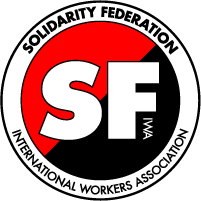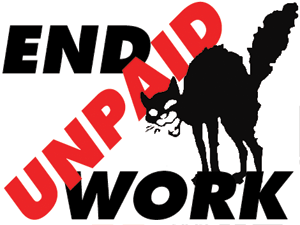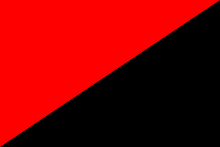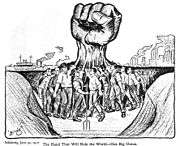Solidarity Federation
 | |
| Full name | Solidarity Federation |
|---|---|
| Founded | 1950 |
| Affiliation | International Workers Association |
| Country | United Kingdom |
| Website | www.solfed.org.uk |
The Solidarity Federation, also known by the abbreviation SolFed, is a federation of class struggle anarchists active in Britain. The organisation advocates a strategy of anarcho-syndicalism as a method of abolishing capitalism and the state, and describes itself as a "revolutionary union initiative".[1] In 1994 it adopted its current name, having previously been the Direct Action Movement since 1979, and before that the Syndicalist Workers' Federation since 1950.
History
Syndicalist Workers' Federation
The Syndicalist Workers' Federation was a syndicalist group in active in post-war Britain,[2] and one of the Solidarity Federation's earliest predecessors. It was formed in 1950 by members of the dissolved Anarchist Federation of Britain (not to be confused with the current Anarchist Federation which was founded as the Anarchist Communist Federation in 1986). Unlike the AFB, which was influenced by anarcho-syndicalist ideas but ultimately not syndicalist itself, the SWF decided to pursue a more definitely syndicalist, worker-centred strategy from the outset.
The group joined the International Workers Association and during the Franco era gave particular support to the Spanish resistance and the underground CNT anarcho-syndicalist union, previously involved in the 1936 Spanish Revolution and subsequent Civil War against a right-wing military coup backed by both Nazi Germany and Fascist Italy. The SWF initially had some success, but when Tom Brown, a long-term and very active member was forced out of activity, it declined until by 1979 it had only one lone branch in Manchester. The SWF then dissolved itself into the group founded as the Direct Action Movement.
Its archives are held by the International Institute of Social History, and a selection of the SWFs publication have been digitally published on libcom.org.
Direct Action Movement
The Direct Action Movement was formed in 1979, when the one remaining SWF branch, along with other smaller anarchist groups, decided to form a new organisation of anarcho-syndicalists in Britain.[3]
The DAM was highly involved in the Miners' Strike as well as a series of industrial disputes later in the 1980s, including the Ardbride dispute in Ardrossan, Scotland, involving a supplier to Laura Ashley, for which the DAM received international support. From 1988 in Scotland, then England and Wales, the DAM was active in opposing the Poll Tax.[4]
In the early 1990s, DAM members set up the Despatch Industry Workers Union, which successfully organised workers for a number of inner-city courier firms.[5]
The DAM was also involved in Anti-Fascist Action (AFA), and was committed to physically combatting British fascist and far-right groups. It often had encounters with groups such as the National Front and the British National Party. Anti-fascist activities in places such as Liverpool, Yorkshire, Bristol and Norwich were heavily influenced by local anarchists. Similarly anarchists, in particular the DAM, were the first to question the motives and tactics of the anti-fascist Searchlight magazine.
In March 1994, DAM changed its name to the Solidarity Federation. Presently, the Solidarity Federation publishes the quarterly magazine Direct Action (presently on hiatus) and the newspaper Catalyst. Several locals and networks also publish their own newsletters. Along with the Anarchist Federation it is one of the two anarchist federations active in the UK at the present time.
Federalism
The Solidarity Federation organises according to the principles of anarchist federalism. The base unit of the federation is the Local, groups of members based within a specific geographical area. These local groups are autonomous, within the bounds laid out in the Solidarity Federation's constitution. These local groups come together as a confederation to form the national organisation. This most importantly manifests at the national conference, where each local presents a delegate to represent them. These local delegates do not act independently, but instead are guided by the mandate (formal instructions) their fellow members have given them. In this way, the Solidarity Federation is an attempt at a working grassroots democracy. This confederated national conference is the highest decision making body in the Solidarity Federation.
Internationally, the Solidarity Federation forms the British section of International Workers Association, an international federation of anarcho-syndicalist unions and groups. With the IWA also following the principles of federalism, the Solidarity Federation plays a role in the IWA similar to that of a local in SolFed, as a group of members organised by geographical region. All SolFed members are automatically members of the IWA.
Workplace organising
Industrial Networks
Solidarity Federation members who work in the same employment sector have formed Industrial Networks. Their purpose is to promote solidarity amongst workers and focus on developing and implementing a direct action strategy to fight for better pay and conditions in their industry. The most active network is the Education Workers’ Network.
Organiser Training (open course)
Solidarity Federation are responsible for supplying volunteer staff to run a workplace organiser training course intended to "give people the tools and confidence to organise in their workplaces and win grievances".[6] This training is open to non-members and focuses on how building a 'shop committee' can form a platform by which to initiate an effective anarcho-syndicalist approach to workplace issues.
Activities
Workmates

In the late 1990s, track maintenance workers on the London Underground faced being outsourced to a private contractor under a Public-Private Partnership (PPP) scheme. The aim of the PPP was to cut costs by introducing competitive tendering by private contractors to do the work which had previously been done in-house. This casualisation would undercut the hard-won terms and conditions of London Underground staff and replace relative job security with the temporary, insecure employment that has become so widespread under the mantra of the ‘flexible labour market’.
London Underground workers were mainly organised with the Rail, Maritime and Transport union. However third-party contractors and casual staff were typically not unionised. Andy, an RMT union rep and anarchist, sought to utilise anarcho-syndicalist tactics like mass meetings and on-the-job direct action to overcome divisions between union and non-union workers, and build resistance to the increasing privatisation and outsourcing on the London Underground, itself a tactic used to divide and rule the workforce.
This led to the founding of the Workmates collective in late 1998/early 1999, a workplace group based out of a London maintenance depot. Workmates was open to all workers regardless of union membership, and sought to organise action on the shop floor, controlled by the workers themselves. The Workmates collective was fully functioning with a delegate council structure for around 18 months into mid-2000. During this time they organised numerous actions with varying degrees of success until staff turnover and the strain on a small number of core activists took its toll. Despite this, the culture of canteen mass meetings has continued for the last decade, and workplace meetings open to all workers are ongoing as of 2011.[7]
The experience of the collective is documented in the Workmates pamphlet, produced as part of Solidarity Federation's ongoing Theory and Practice series.
End Unpaid Work

In early 2012, Solidarity Federation initiated a national campaign against workfare.[8] The organisation describe workfare as a government initiative to implement 'schemes in which people are forced to work without wages in order to receive their benefits'.[9] Solidarity Federation further claim that workfare is 'part of a long term re-structuring of the labour market towards more temporary, lower paid jobs and with poorer conditions and fewer benefits'[10] by 'placing significant downward pressure on the wages and conditions of those of us who work.'[10]
The campaign initially focused specifically on Holland and Barrett, a health supplement corporation making use of placements staffed by unpaid benefits claimants. On 5 July 2012, after a sustained series of pickets at Holland and Barrett stores across the UK, the company announced via social media and its website that it was pulling out of the workfare scheme, citing negative publicity.[11][12][13] This announcement came just days before a national 'week of action against workfare', organised jointly with Boycott Workfare, was due to begin.[13]
A Solidarity Federation spokesperson speaking to The Guardian newspaper described the victory as:
| “ | ...not just a victory for claimants, [but] a victory for all of us as workfare undermines pay and conditions [14] | ” |
Locals
- Belfast
- Brighton
- Bristol
- Calderdale
- Hull
- Liverpool
- Manchester
- Newcastle
- North London
- Northampton
- Solent
- South London
- Thames Valley
See also
References
- ↑ http://www.solfed.org.uk/solfed-industrial-strategy
- ↑ Encyclopedia of British and Irish Political Organizations'. United Kingdom: Pinter Publishers. 2000. ISBN 978-1855672642.
- ↑ http://www.katesharpleylibrary.net/x69qfd
- ↑ Meltzer, Albert (2001). I Couldn't Paint Golden Angels. United Kingdom: AK Press. ISBN 978-1873176931.
- ↑ http://libcom.org/library/the-couriers-are-revolting-the-despatch-industry-workers-union-1989-1992
- ↑ http://www.solfed.org.uk/organiser-training
- ↑ Workmates. United Kingdom: Solidarity Federation. 2011.
- ↑ http://www.solfed.org.uk/campaigns/workfare
- ↑ http://www.solfed.org.uk/unwaged-workers/abolish-workfare-the-solidarity-federations-guide-to-the-governments-unpaid-work
- 1 2 Abolish Workfare (PDF). United Kingdom: Solidarity Federation. 2012.
- ↑ "Statement regarding Holland & Barrett and the Government Work Experience scheme". Holland and Barrett. Retrieved 16 July 2012.
- ↑ http://www.newstatesman.com/blogs/politics/2012/07/workfare-goes-underground-holland-and-barrett-pull-out
- 1 2 http://www.solfed.org.uk/brighton/a-domino-falls-holland-barrett-quit-workfare-after-direct-action
- ↑ http://www.guardian.co.uk/uk/2012/jul/06/holland-and-barrett-jobseekers-scheme
External links
- Solidarity Federation website
- Catalyst newspaper
- List of Solidarity Federation local sections
- Liverpool Solidarity Federation website
- Solidarity Federation archive at libcom.org


